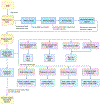A replicable, open-source, data integration method to support national practice-based research & quality improvement systems
- PMID: 35994859
- PMCID: PMC9810436
- DOI: 10.1016/j.eplepsyres.2022.107013
A replicable, open-source, data integration method to support national practice-based research & quality improvement systems
Abstract
Objectives: The Epilepsy Learning Healthcare System (ELHS) was created in 2018 to address measurable improvements in outcomes for people with epilepsy. However, fragmentation of data systems has been a major barrier for reporting and participation. In this study, we aimed to test the feasibility of an open-source Data Integration (DI) method that connects real-life clinical data to national research and quality improvement (QI) systems.
Methods: The ELHS case report forms were programmed as EPIC SmartPhrases at Mass General Brigham (MGB) in December 2018 and subsequently as EPIC SmartForms in June 2021 to collect actionable, standardized, structured epilepsy data in the electronic health record (EHR) for subsequent pull into the external national registry of the ELHS. Following the QI methodology in the Chronic Care Model, 39 providers, epileptologists and neurologists, incorporated the ELHS SmartPhrase into their clinical workflow, focusing on collecting diagnosis of epilepsy, seizure type according to the International League Against Epilepsy, seizure frequency, date of last seizure, medication adherence and side effects. The collected data was stored in the Enterprise Data Warehouse (EDW) without integration with external systems. We developed and validated a DI method that extracted the data from EDW using structured query language and later preprocessed using text mining. We used the ELHS data dictionary to match fields in the preprocessed notes to obtain the final structured dataset with seizure control information. For illustration, we described the data curated from the care period of 12/2018-12/2021.
Results: The cohort comprised a total of 1806 patients with a mean age of 43 years old (SD: 17.0), where 57% were female, 80% were white, and 84% were non-Hispanic/Latino. Using our DI method, we automated the data mining, preprocessing, and exporting of the structured dataset into a local database, to be weekly accessible to clinicians and quality improvers. During the period of SmartPhrase implementation, there were 5168 clinic visits logged by providers documenting each patient's seizure type and frequency. During this period, providers documented 59% patients having focal seizures, 35% having generalized seizures and 6% patients having another type. Of the cohort, 45% patients had private insurance. The resulting structured dataset was bulk uploaded via web interface into the external national registry of the ELHS.
Conclusions: Structured data can be feasibly extracted from text notes of epilepsy patients for weekly reporting to a national learning healthcare system.
Keywords: Epilepsy; International League Against Epilepsy; Learning Health System; Quality Improvement; Seizure control; Text analytics.
Copyright © 2022 Elsevier B.V. All rights reserved.
Conflict of interest statement
Declarations of Interest None.
Figures





References
-
- Barbour K, Hesdorffer DC, Tian N, Yozawitz EG, McGoldrick PE, Wolf S, McDonough TL, Nelson A, Loddenkemper T, Basma N, Johnson SB, Grinspan Z, 2019. Automated detection of sudden unexpected death in epilepsy risk factors in electronic medical records using natural language processing. Epilepsia 60 (6), 1209–1220. 10.1111/epi.15966. - DOI - PMC - PubMed
Publication types
MeSH terms
Grants and funding
- K08 AG053380/AG/NIA NIH HHS/United States
- R01 NS102190/NS/NINDS NIH HHS/United States
- UL1 TR002541/TR/NCATS NIH HHS/United States
- RF1 AG064312/AG/NIA NIH HHS/United States
- R01 AG062282/AG/NIA NIH HHS/United States
- R01 NS102574/NS/NINDS NIH HHS/United States
- P01 AG032952/AG/NIA NIH HHS/United States
- K08 NS118107/NS/NINDS NIH HHS/United States
- R01 NS107291/NS/NINDS NIH HHS/United States
- U48DP006377/ACL/ACL HHS/United States
- R01 AG073410/AG/NIA NIH HHS/United States
- RF1 NS120947/NS/NINDS NIH HHS/United States
- U48 DP006377/DP/NCCDPHP CDC HHS/United States

